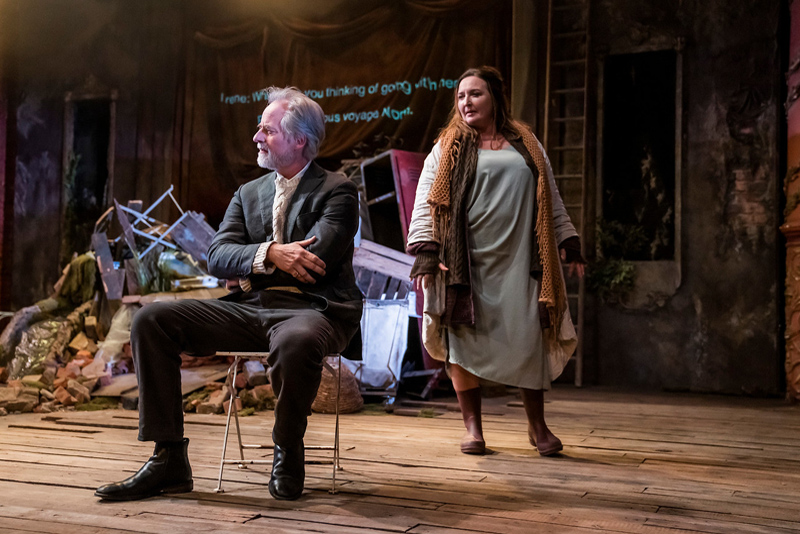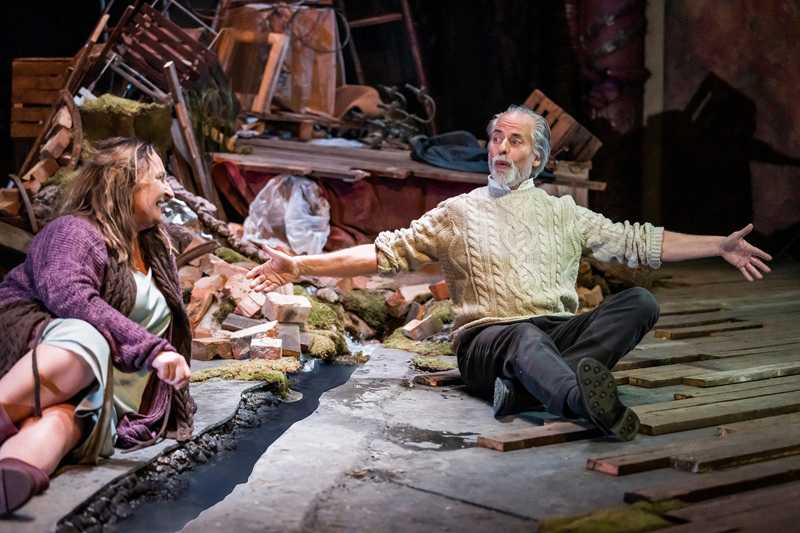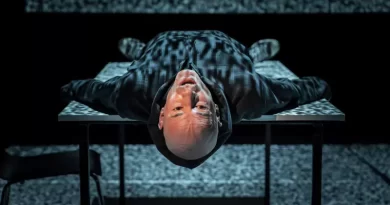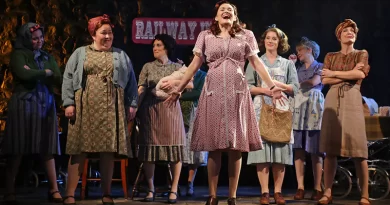“When We Dead Awaken”: Coronet Theatre
Tom Bolton in Notting Hill Gate
4 March 2022
Jonathan Kent opened his tenure as Artistic Director of the Almeida Theatre with a production of Henrik Ibsen’s final play When We Dead Awaken in 1990. When, years later, he was asked for his advice to young directors he supposedly said, “Don’t start with When We Dead Awaken”. Kent’s production was well received and his time at the Almeida a triumph, but the play is notoriously difficult. If anyone can get to grips with its strange combination of symbolism and despair, it is surely The Norwegian Ibsen Company. Previously seen at the Coronet Theatre with strong versions of Little Eyolf and The Lady from the Sea, they return with a production directed by 81-year-old Kjetil Bang-Hansen who is internationally renowned for his Ibsen productions and makes a belated UK debut. If the play remains difficult to love, it is hard to imagine a more powerful, well-produced account of its strengths and weaknesses.

Øystein Røger and Ragnhild Margrethe Gudbrandsen.
Photo credit: Tristram Kenton.
The set, designed by Mayou Trikerioti, extends the abandoned late-nineteenth-century music hall ambience of the Coronet onto the stage itself. Peeling paintwork on the balconies gives way to a derelict stage with floorboards torn up, dominated by a pile of junk heaped in front of a painted proscenium arch. These are the remnants of an abandoned theatre, where the audience has departed for the last time. It neatly sums up the desolate mood of Ibsen’s farewell work, which seems to be a complete renunciation of his artistic achievements. It is an astonishing play in many ways, but not all of them are good. Ibsen was apparently dissatisfied with what we now regard as his great plays – such as Little Eyolf and The Master Builder – that he felt said nothing new.
The central character of When We Dead Awaken is the aging sculptor Arnold Rubek, whose greatest work is behind him and who is now condemned to what he considers ‘hack work’. His young wife Maia can no longer connect with him and, when he encounters his former model Irene, who posed for his masterpieces, he follows her where she leads. His final journey with her to the top of the mountain is heavy with symbolism – Lohengrin, boats that run ashore, the “murder” of children, resurrection, light, darkness, seagulls, swans, and a stream that erupts, startlingly, from the set.

Ragnhild Margrethe Gudbrandsen and and Øystein Røger.
Photo credit: Tristram Kenton.
The cast, who perform mostly in Norwegian with English surtitles, as well as some scenes in English, inhabit the unreal world of the play completely. Øystein Røger, as Rubek, has natural authority which conceals a complete collapse in his confidence or sense of self. He has returned to his Norwegian home town, against his better judgement, to look for meaning in his life. Maia, played by Andrea Bræin Hovig with frustrated energy, has given up hope that her husband will take her, as he promised, to the top of the mountain to see the glories of the whole world. The supposed settings – a country hotel and a mountain retreat – seem like painful fantasies and, when other figures appear, they appear to have been conjured from the troubled minds of Rubek and Maia.
First, Ulfhejm (James Browne), a bear hunter, captivates Maia and takes her away to show her something exciting (apparently his dogs feeding). He later offers to tie her up with their leashes. Then Rubek recognizes Irene von Satow, his muse and saviour/nemesis, played by Ragnhild Margrethe Gudbrandsen. She glides into the picture, accompanied by a nun, both real and spectral, and leads Rubek to the top of the mountain, up a path that Maia and Ulfhejm find much too dangerous. What happens next is not entirely clear, and Ibsen was apparently unsure how to end the play, but both Rubek and Maia are set free in contrasting ways.

Ragnhild Margrethe Gudbrandsen.
Photo credit: Tristram Kenton.
There are a number of problems with When We Dead Awaken. In abandoning the realism that proved so effective in plays such as Little Eyolf when combined with elements of the supernatural, it seems self-indulgent. The dreamlike setting makes it hard to take events seriously but, while it could perhaps be said that Ibsen is mocking his own status as a great artist, the play contains little in the way of humour. Rubek, unlike the characters for whom Ibsen is famous, seems clichéd – a tortured, self-absorbed artist who treats others, both Maia and Irene, abominably. Our sympathies for Rubek are rapidly lost as he retreats inside his own self-pity, and it is hard for us to care much about his redemption. Meanwhile, it is disturbing to see how Ibsen, at last writing about what he really felt, had nothing much left to say. The darkness that overwhelms him is like an onstage breakdown, distressing to watch and a harsh coda to a career that, more than a century later, seems a triumph.
However, despite the play’s inherent strangeness, The Norwegian Ibsen Company offers a rare and valuable opportunity to see When We Dead Awaken. The confidence of the performers and the memorable staging, not to mention the alluring sound of Norwegian spoken on stage, make this an evening of high-quality theatre for more than just Ibsen completists. The Coronet continues to play an important role in the London theatre scene, hosting European companies who would not otherwise be seen in the UK, and widening our cultural horizons in ways that we should not take for granted.









